
The bold, weathering-steel corner volume at Five88 frames a gateway to San Francisco’s evolving Mission Bay neighborhood.
Today, nearly every community needs attainable and affordable housing. For architects, developers, and policymakers, responding to this need is increasingly challenging. Many obstacles exist, from complex financing structures to NIMBYs, shrinking budgets and soaring construction costs. As architects striving to create successful housing that fosters stability and connection, we work hard to develop community-oriented designs that endure throughout the development process. Over the years we have learned the best way to achieve housing that supports thriving communities is integrate this priority into the core of the design from the outset.
Through our extensive experience designing urban places, we have codified a suite of complementary strategies that are crucial for creating human-centric housing that bolsters resilient communities. This framework, which we call “Nine Ways to Make Housing for People,” is fundamental to our practice and ensures care is taken and expressed at every level. These strategies range from structural to sensorial, enhancing the building experience.
These nine design approaches (articulated in our book, "9 Ways to Make Housing for People"), are straightforward yet often overlooked. The challenge lies in preserving them throughout the design, development, and construction process–recognizing their value, coordinating their implementation, and advocating for their importance. If you believe in—and can articulate—the cumulative positive effect of these strategies, you can make a compelling case at each step of the way to keep them in the design.
Reweave the Urban Fabric: Create, repair, and enhance connections within existing neighborhoods. Ask, “What does this place need to stay vibrant or be brought back to life? How can this building anchor, repair, or support this neighborhood?”
Make Big Moves: Design a bold and interesting building form. In this way, you can distinguish a building without relying solely on expensive material, which could be removed the project. Commit to a significant architectural move that impacts the structure organically from the site, context, or other conditions, and withstands alterations in cladding.
A Little Goes a Long Way: Focus premium materials in areas of shared enjoyment while keeping it simple elsewhere. Honor and respect residents with enhanced features or finishes, used judiciously in high-visibility spots and areas with strong communal use.
Activate the Edges: Energize the streetscape with a generous, thoughtful, mixed-use ground floor. This is where most people—residents and neighbors—experience the building.
Be Welcoming: Establish a positive atmosphere with a bright and engaging entryway. Take care with the placement, approach, and details of the entry sequence to ensure that the building is inviting, inclusive, and easy to navigate.
Cultivate Connection: Place compatible uses together to add convenience, support social encounters, and build lasting bonds. Remember that good housing is more than just good shelter, it is a place for making meaningful human connections.
Enlightened Circulation: Bring light and fresh air into hallways and stairs to connect with nature and encourage walking. Treat circulation spaces -- entries, corridors, stairways -- as the communal areas they are, and be sure people feel good meeting in and moving throughout the building.
Art For All: Use art to invigorate common spaces, help with wayfinding, and create a strong visual identity. Embedding artwork on and in buildings is an opportunity for color, texture, identity, and evidence of the human touch.
Get Personal: Reflect the character of the community and offer opportunities for personal expression. Provide places for people to make their mark.
A vital part of building housing for people is engaging with current and future residents, and then applying these ideas. We have found the most potent way to design is to put human dignity at the center of the process, and then cultivate the idea that the way we live in relationship to people and place shapes the health, resilience, and character of a city.
Using this framework, we design with equal parts joy and tenacity, and we encourage you to make those qualities characteristic of your process as well. Staying with the design—going to the mat for these key elements—is crucial to ensuring that quality and a sense of place endure. This includes understanding connections between design decisions and residents’ quality of life. The complexity of multifamily housing design and construction is astounding but not insurmountable. Take the time and make the case—sometimes again and again—for the moves that matter most.
Collectively, these strategies are a tool for designers, developers, and owners. They combine to heighten the effectiveness, utility, comfort, and enjoyment of a completed building or community, and can do so while meeting the budget—especially if they are understood and committed to in the early stages.
View the full article: Joy and Tenacity: Defending Design for Housing that Works, which appeared in ARCHITECT Magazine on May 2, 2024.





